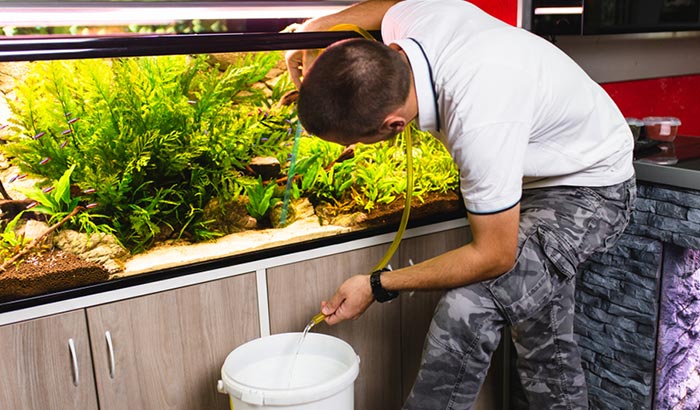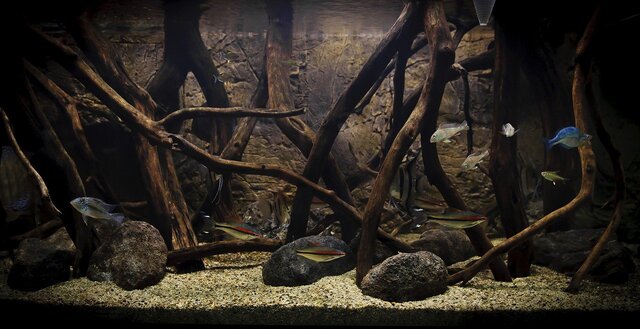Water conditions is absolutely crucial when it comes to fish keeping. That’s because water is your aquatic critters’ habitat. So, what’s in it plays an important role in your pet’s well-being. Of course, you want to provide them the best care you can so that they will thrive happily and healthily.
One thing in the water chemistry that you need to monitor regularly is the pH levels. You need to make sure that your water pH is low and keep it so. Unfortunately, not every aquarist knows this immediately when they begin their aquarium journey.
The lack of knowledge on the importance of the correct pH levels can be dangerous. Many people fill their tanks with tap water, which they think is fine, while it actually contains a high alkaline.
That’s why we will discuss all the things you need to know about pH levels. We will cover the ideal pH levels, why it is essential, and most importantly, how to lower the pH levels in your tank when it gets too high.
Table of Contents
What is pH?
pH is a very common term in the water world. Not only about the aquarium water, water or soap companies even include the pH level of their products on the packaging. So yes, it is that important. But what is pH precisely?
You probably have learned about water molecules in school. If you remember it, water consists of hydrogen and oxygen. The two molecules split, and some of them lose hydrogen and become hydroxide ions.

Water pH refers to the water chemistry, and it stands for “Power of Hydrogen”. It measures the acidity and alkalinity of water. The pH scale goes from 0 to 14. Neutral or pure water has a pH of 7, meaning that the number of hydroxides (OH-) and hydrogen ions (H+) are equal. A pH level below that is acidic and above that is alkaline.
pH can change when an acidic or alkaline substance dissolves in the water and change the balance of ions. A basic (alkaline) substance soaks up the hydrogen molecules and creates more hydroxide ions, increasing the pH level in your aquarium. On the other hand, an acidic substance will raise the hydrogen molecules, thus lowering the pH.
Strong acids have pH level near zero, which make them dangerous for people and other living things. They can even dissolve metals! Very alkaline substances that have a pH level near 14 are just equally dangerous. A few examples are bleach and other cleaning solutions.
What is the ideal pH for a fish tank?
Obviously, there is no one valid answer to this question. The reason is that fish and other aquatic creatures you have in your tank come from various places. They are originally from rivers, lakes, ponds, and other water bodies from various areas that have different pH levels.
Normally, pH levels range from 5.5 up to 8.5 in a freshwater fish tank. The level is also not fixed as it will increase and decrease frequently. pH level will typically increase at night and decrease in the day.
That’s why, the “ideal” pH level doesn’t apply in all aquariums, instead, it depends on the fish breed. Some fish prefer acidic water with a pH lower than 7.0, while others can live in waters with a pH level as high as 8.5.
Different pH for Different Fish
Previously, we mentioned that there’s no ideal pH level for a fish tank because each fish have their own requirements. There are fish that come from waters with low and high pH levels. Therefore, you need to mimic the natural water condition in their natural habitat if you wish to house them. Here we have a list of some low pH and high pH fish to give you some reference.
Fish that prefer high pH levels:
- Swordtails
- Lake Malawai Chiclids
- Lake Tanganyika Chiclids
- Mollies
- Guppies
Fish that prefer low pH levels:
- Harlequin Rasboras
- Pearl Gourami
- Discus
- Rams
- Cardinal Tetras
Things That Cause Water pH to Increase
Before we learn about how to decrease pH levels in tank waters, it’s better to know what causes your water pH to spike first. Below are some possibilities that can raise the water pH, accidentally or not.
- Adding untreated water (water from rainwater borehole, streams, and ponds) into the tank
- Carbon dioxide depletion. Usually caused by trace mineral from tap water you use to fill the tank with
- Fish medications or other alkalinity supplements
- Fish food and Bioloads
- Aquarium decors and substrates
Ways to decrease pH levels in your tank
High pH levels in fish tanks are dangerous for the tank inhabitants. Testing the water regularly to detect if there’s anything wrong with the water is essential. If the test result shows a high level of pH, you need to take immediate action to fix the issue.
Perform Partial Water Changes

This method is perhaps the quickest and easiest way to lower the pH levels in your tank. Besides, it also works immediately without needing any waiting time.
Changing the water partially, around 10% every day or 30% every five days, is fundamental. This is easier than changing all the water at once because it requires you another place for the critters. Don’t forget to clean your substrates and decors, too, when you perform a water change. We don’t recommend using soap, detergent, or any other chemicals to clean the decors as they might affect the water chemistry later. Just wash them with clean water.
The reason why partial water change is necessary is that there is fish waste, leftover fish meals, or decaying plant matters inside the aquarium. If being left for too long, they will cause ammonia to build up and increase the pH levels, which is bad for the fish.
In addition, aquarium water also evaporates, and the water that’s left behind is more alkaline due to the dissolved minerals. And as we all know, alkaline water is not the best for your aquarium residents. Therefore, changing the water regularly is essential to keep the pH level neutral.
Add Some Driftwoods

Another alternative to reduce pH levels is to introduce some driftwoods into your tank. This aquatic decor is an easy and natural way to make your tank water less alkaline. Besides, it might also benefit your fish!
However, that’s not always the case. Before you decide to put driftwoods inside your pre-existing aquarium, it’s better to do some research on whether your tank inhabitants will love it or not. On top of that, you will also have to find driftwoods that are specifically designed for aquariums.
There are some nice and beautiful driftwoods for sale you might want to pick. But first, you need to make sure whether it’s originally made for reptiles. If so, that’s already a no for your tank. Driftwoods for terrariums contains chemicals that might be safe for reptiles, but not for aquatic creatures, as it is not meant to be underwater.
So, how do driftwoods help to lower the pH levels? Well, they release tannins that can reduce pH. However, tannins will also add yellow or brown coloration to the water. If your tank has a natural, river theme, driftwoods may be suitable for you.
Before adding driftwoods into the aquarium, you can prepare them by boiling them in saltwater to sterilize. It will also weaken the discoloration they might cause.
Peat Moss

This one is probably the most popular technique to tackle high pH levels in tank water. Not without reasons, though. Besides being a natural way of lowering the pH, peat moss is also easy to obtain and use.
You can get this moss in your local pet stores or nursery in the form of chunks or pellets. To use it, you can simply place chunks of peat moss in your filters.
Peat moss needs to stay in the water for it to work properly. Just dipping it inside your tank won’t help. Adding some peat pellets directly to the water will also disturb the aesthetic as the peat moss will float around freely.
Peat moss will decrease the pH level by releasing gallic acids (it’s acidic) and tannins. It contains even higher tannins than driftwoods. The peats attack bicarbonates and prevent them from piling up, thus keeping the pH levels in your water stable.
However, since peat moss releases tannins, it will discolor your water and makes it looks like tea water. If you are more into the natural look, this won’t be a problem for you. But if you value crystal clear water, then we recommend trying other methods on this list. You can also soak the peat moss in another container before adding it into your tank, but it won’t completely stop the yellow-brownish water from happening.
Using peat moss to decrease the pH level is tricky as there is no fixed amount on how much to use it. What you can do is take a small portion of the peat moss, test the water, then add some more if the water is still too alkaline.
Add Some Catappa Leaves (Indian Almond Leaves)

Putting some catappa leaves inside your tank is another natural way to reduce the water pH. Also known as Indian Almond leaves, catappa leaves come from Terminalia Catappa trees which are native to Africa, Asia, and Australia.
Just like driftwoods and peat moss, almond leaves leach tannins into the water, and therefore, cause the water to change color. But don’t worry, the discoloration won’t harm your aquatic pets. In fact, it can create a more natural look (if it suits your aesthetics).
It won’t stain your water as intensely as driftwoods or peat moss does, but you can perform the same step to cut back the discoloration. Pre-soak the catappa leaves in a separate water container for a day before adding them to your tank. You can also just pour the water you used to soak the leaves earlier into your aquarium if you don’t like having rotten leaves inside it.
The tannins released by catappa leaves as they are decaying decrease water hardness, and so it will also lower water pH. On top of that, Indian almond leaves are also scientifically proven to prevent fungal and bacterial growth inside tanks! They are known to be antibacterial, anti-inflammatory, and anti-oxidant. What more could you ask?
CO2 Reactors
This one is a bit different than the previous pH reducing methods since it’s not a natural way. Besides, it’s also not very common to use a CO2 reactor merely to lower the pH in the aquarium water. However, if you own live plants in your tank, a CO2 reactor can be beneficial.
Plants need carbon dioxide, and the CO2 reactor provides exactly what the plants need as long as the reactor is working. You will notice the visual of the gas exchange cycle of your ecosystem by seeing air bubbles forming on your plants’ leaves. This happens because the plants photosynthesize. They produce so much oxygen that creates a stream of bubbles.
But the most important point is that CO2 can lower your water pH. Carbon dioxide acts as an acid in the water, thus preventing your water from getting too alkaline.
Besides relying on reactors, you can also try some organic matters to add carbon dioxide into your water. Some recommendations are cracked corn, soybean meal, and cottonseed meal. These organic matters release carbon dioxide slowly as they decompose.
Add a pH Lowering Chemical Solutions
Adding some drops of chemical solutions can also lower the pH levels in your water. However, that might not be the most effective way as the result doesn’t last long, and you need to repeat adding chemicals to maintain your water pH.
You can easily find some pH lowering products out there labeled as pH Reducer, pH Lower, or Water Softener. The active ingredients are different in each of the products. Usually, it uses diluted synthetic acids, but some use “natural” ingredients like tannins or other organic stuff.
Although chemical solutions can quickly decrease the water pH, you should only use them as a last resort. Chemical solutions are sometimes too strong and can even kill your fishess. That’s why you always need to read the label first and only use the product according to the directions.
Use Reverse Osmosis
This method is perhaps the most efficient and safest way to decrease the pH in your aquarium. Not only that, but RO devices can also maintain your water parameter at its optimum condition.
Reverse Osmosis works by filtering out bigger molecules and only letting tiny molecules (H2O) pass-through by using semipermeable membranes. By doing so, RO filters eliminate 90% to 99% of harmful substances like arsenic, insecticides, pesticides, and heavy metals, thus resulting in completely pure water.
Pure water means it’s neutral, not alkaline or acidic, with a pH level of 7.0. It doesn’t have a color, smell, and is totally clean and safe, which is perfect for promoting the well-being of your aquatic pets.
Although RO filters are famous for their excellence, it still has a downside. The price is not very cheap and you need to replace the filters now and then. You will need to spend a few hundred dollars for a high-quality RO device, so don’t be deceived by a cheap RO unit you see in the market.
Due to its price, we recommend getting an RO unit if the tap water in your area is rich in minerals or treated with chemicals. RO filters are also more suitable if you own larger tanks and don’t have much time to test and adjust the pH level every few days. But if you have already installed an RO unit in your household, you can just fill your tank (any size) with tap water without worrying about the pH.
Avoid Changing Decors and Substrate Frequently
Last but not least, reduce the frequency level of switching substrates. This one is also an easy alternative to prevent your water pH from raising.
Adding a new substrate or changing it might be fun and aesthetically pleasing for the eyes. However, it might result in bad news for your water chemistry and tank inhabitants.
Substrates like crushed corals and limestones, and additional décor like shells, are known to release minerals into the water, therefore increasing the pH.
If you wish to lower your pH and maintain it, say farewell to your changing substrate hobby.
Final Words
It’s important for every aquarist to not aim for the “perfect” pH in their tank water. pH levels should be adjusted according to the fish breed and other critters you own, so make sure to do some research on their requirements beforehand.
As pH levels tend to drop and rise drastically, testing your water at least once a week is crucial. This will help you find out if there’s an issue so that you can solve it immediately. Once fixed, water conditions needs to be maintained in optimal conditions.
Now that you’re equipped and know what to do if you face pH changes in your water, you’re good to go. If you have any experiences or tips about water pH in your tank, please feel free to share them with us.






